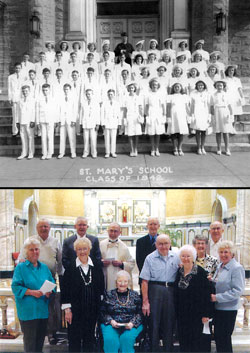Catholic Schools Week Supplement
‘It all goes back to our roots’: Great divide becomes special bond for classmates who still meet after 71 years

Top photo: photo captures boys and girls from the Class of 1942 at St. Mary’s Catholic Academy in New Albany. Surviving members of that class still get together for monthly luncheons 71 years after they graduated from grade school. Bottom photo: 11 members of the Class of 1942 of St. Mary’s Catholic Academy in New Albany pose with Dominican Father Emmanuel Bertrand, a member of the class, after a Mass at St. Mary Church during the summer of 2012 as the class celebrated its 70-year reunion. (Submitted photos)
By John Shaughnessy
It’s a fun story about the differences that sometimes divide boys and girls in the same grade in a Catholic school.
Marked by laughter and memories, it’s also a timeless story about the bonds that sometimes connect those same boys and girls in an amazing way.
And “amazing” seems a good word to describe a group of male and female classmates, who still meet regularly nearly 71 years after they graduated from grade school together.
“It’s kind of a special bond we have,” says Ann Sadtler, one of the graduates of the Class of 1942 of St. Mary’s Catholic Academy in New Albany. “We really look forward to being with one another. We have a ball.”
Yet that closeness wasn’t always on display. For the first five years of grade school, the boys were taught in one building while the girls received instruction in another.
But the true divide started after the boys and girls were combined into one building in the sixth grade—a move that eventually led to a classic showdown between the boys and the girls over the all-important issue of playground rights.
On one side, there were the girls who had been content to spend the first five years of their Catholic education in a parish building that had two key features from the girls’ view: It was modern, and there weren’t any boys in it.
On the other side, there were the boys who had been thrilled to spend the first five years of their Catholic education in another parish building that had two key features from the boys’ perspective: It had a great playground, and there weren’t any girls in it.
In the midst of this utopia, the decision was made that it would be better for the boys and girls at the parish to actually attend school together in the same building.
It wasn’t a popular decision as far as the boys and girls were concerned. Still, they managed to keep a peaceful co-existence—with the exception of the one boy who boycotted the class photo as a matter of principle—until one day when the girls wanted to play kickball on the boys’ paved playground instead of the cinder alley that passed for the girls’ playground.
The boys balked. The principal said the boys had to share. The boys protested and staged a sit-down strike on the playground—a strategic counterattack that drew the attention of the pastor of the parish. He declared that the boys could continue their sit-down strike by sitting in the bleachers for a month and watching the girls play kickball on the paved playground.
“Women’s Lib had its first movement,” says a laughing Trudy Peak as she recalls one of the defining stories of her class.
Yet the most defining story of that class is that its graduates still get together every month for lunch 71 years later.
“Everyone enjoys each other’s company,” says Peak, who is credited by her classmates for keeping the group together. “For a while after we left school, we all went into different lives. But after you get older and do things in your life, you think about the people you grew up with and the memories you had together.”
There were 47 members of their graduating class. Twenty-four classmates are alive. The classmates included a doctor, a priest, an engineer, a chemist, teachers, business owners, homemakers and two religious sisters. The reunions began when the religious sisters, who were missionaries, returned home to visit with family and friends.
“I ran into one of the boys one time and he said, ‘Do you ever see anyone from school?’ ” Peak recalls. “I told him the girls get together. He said, ‘Why don’t you include the boys?’ So we did. The first year we got together, we were adults with families, and still the boys lined up on one wall and the girls lined up on the other.”
Reunions followed every five years until 2002 when someone suggested that the group was approaching “the short end of life” so meetings should be held monthly. Now, the group meets at Sam’s Food and Spirits in New Albany. About 20 people show up every time, including spouses and grown children who drive their parents to the lunches.
“You don’t see many kids who were in school together in the late ‘30s and early ‘40s who have stuck together like this,” says Ed Roth, a member of the class. “Maybe it has something to do with us not coming together until the sixth grade. It’s a special day when I get to have lunch with them, and they all make me feel loved. It’s really fantastic.”
Classmates send flowers and cards of comfort when someone is ill. They sit together as a class at funeral Masses. A monthly newsletter is sent, sharing information from their lives and the lives of their children and grandchildren.
“It all goes back to our roots and our friendship in Catholic school,” Peak says. “We learned our morals there. We knew who God was, and we learned to respect each other. Our friendship has been strong. It means a lot to us. We’re always there for each other.” †
